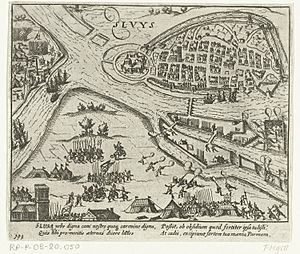Siege of Sluis (1587) facts for kids
Quick facts for kids Siege of Sluis (1587) |
|||||||
|---|---|---|---|---|---|---|---|
| Part of the Eighty Years' War and the Anglo-Spanish War (1585–1604) | |||||||
 Engraving Siege of Sluis of 1587 by Frans Hogenberg. Collection Rijksmuseum Amsterdam. |
|||||||
|
|||||||
| Belligerents | |||||||
| Commanders and leaders | |||||||
| Casualties and losses | |||||||
| 700 killed and 400 wounded | 92 killed and 243 wounded | ||||||
The Siege of Sluis of 1587 was an important battle. It happened between June 12 and August 4, 1587. This event was part of two bigger wars: the Eighty Years' War and the Anglo-Spanish War (1585–1604). When the Spanish captured Sluis, it helped them prepare for a planned invasion of England.
Contents
Why Sluis Was Important
In June 1587, Alexander Farnese, Duke of Parma had a goal. He was the leader of the Spanish army in the Low Countries. He wanted to capture the last two rebel ports in Flanders. These ports were Ostend and Sluis.
Sluis was a very important port. Even though it was getting shallower, it still connected to inland waterways. These waterways were key for moving goods and soldiers. Controlling Sluis was vital for any plan to invade Britain.
The Spanish Attack Begins
The Duke of Parma first tried to attack Ostend. Then, on June 12, 1587, he surrounded Sluis. He did this to cut off the town. However, some English soldiers managed to get into Sluis. Four companies of foot-soldiers arrived from Ostend. They were led by Sir Roger Williams. On June 24, the Spanish started bombing the town.
Attempts to Help Sluis
An English and Dutch army tried to help Sluis. This effort was led by Sir Robert Dudley, Earl of Leicester. He was the Governor-General of the Dutch Republic. Leicester brought about 4,000 foot soldiers and 400 horsemen to Ostend. He wanted to stop the Spanish from getting supplies.
Failed Rescue Missions
Leicester called his soldiers back before they fought the Spanish. A rescue attempt by sea also failed. This attempt aimed to force a path through the channel to the town. These failed efforts made the soldiers defending Sluis feel very discouraged.
After 13 days of constant fighting, the soldiers inside Sluis surrendered. This happened on August 4. They were allowed to leave with their weapons and flags. This was known as "full honours of war."
What Happened Next
The loss of Sluis showed that Leicester had trouble leading his Dutch allies. They did not work well together to help the town. This led to arguments between Leicester and the Dutch leaders.
Leicester's Later Struggles
In the months after Sluis, Leicester tried to attack the Spanish many times. But he was not successful. In September 1587, he failed to capture Leiden. His plans to take Enkhuizen and Hoorn also failed. These were important ports in West Friesland.
Some famous English soldiers fought under Leicester. These included Sir Thomas Baskerville and Sir Francis Vere. On December 16, 1587, Leicester went back to England. The Queen's advisors tried to hold him responsible for his failures. But the Queen protected him.
Spanish Gains
The Duke of Parma, on the other hand, gained a huge advantage. Capturing Sluis allowed him to move boats easily. He could now move them by inland waterways from the Scheldt River to Dunkirk. This was a big step in preparing for the coming Spanish Armada.
See also

